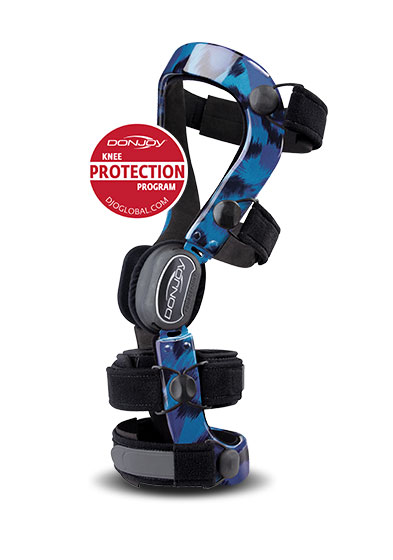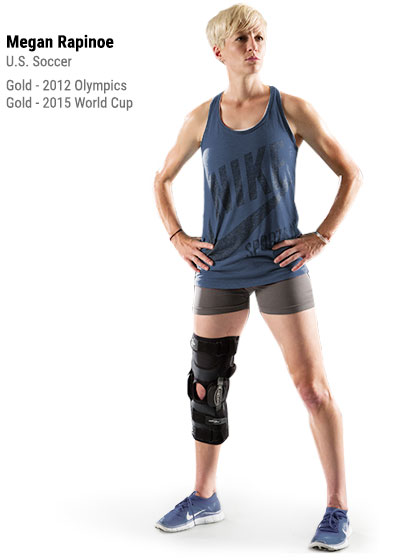ACL Bracing
The Perception
The overall perception of knee bracing technology available to most patients today is that “everyday” knee braces can be unsightly, bulky, heavy, minimally effective, restrictive and uncomfortable. These misconceptions combine to produce “brace anxiety” among many patients, often preventing mainstream adoption and compliance of braces that can help prevent injuries, allow people to remain active while healing, and protect the knee from future injury.
The Reality
Patients are looking for quick, effective and economic options for maintaining or regaining their life activities; most want to delay expensive, invasive surgeries. While some patients are turning to the use of prescription narcotics (which can lead to addiction) and cortisone shots to manage their pain, these treatment options do not provide stability to the knee.
The Facts
Young people between the ages of 15-25 account for half of all ACL injuries.1
A person who has torn their ACL has a 15 times greater risk of a second ACL injury during the initial 12 months after ACL reconstruction2, and risk of ACL injury to the opposite knee is two times that of the restructured knee.3
Many athletes don’t return to sport after ACL reconstruction due to fear of re-injury.4
Bracing for
Prevention
Given the physicality of football, it’s easy to understand why collegiate and professional linemen wear braces on both knees. The line of scrimmage is an environment prone to knee injuries, so team doctors, athletic trainers and coaches don’t hesitate to equip their players with bilateral (both knees) custom braces.
As with helmets and shoulder pads, knee braces have become standard equipment to assist in preventing season-ending knee injuries. And the same logic holds true with skiing, snowboarding, soccer, basketball, volleyball, professional rodeo, water sports and others. An ounce of prevention is worth a pound of cure.
Bracing
Post Injury
Why brace after ACL reconstruction? Clinicians will typically prescribe a functional knee brace after the patient has regained full range of motion—that’s usually between three to five months after surgery. Graft strength of the new ACL is considerably weaker than the native (original) ACL during the first 12 months, so a brace during this early period helps protect it from harmful forces that occur in everyday life or in sport.
Bracing also elevates a patient’s confidence, allowing them to return to their previous or enhanced level of activity. Another important reason? Peace of mind. A functional knee brace provides not only confidence for the patient, but confidence for the surgeon, knowing that their patient’s knee is protected.
The Defiance Brace, Our Flagship Product
Defiance is the world’s leading custom knee brace. More than one-million have been prescribed to athletes of all shapes, sizes, ages and genders. From middle-school soccer players to elite professional athletes, Defiance is the brace athletes trust.
- Sized to perfection, Defiance is custom-made, allowing a broad spectrum of knee sizes to perform at exceptional levels. Constructed of hollow carbon fiber, Defiance has the greatest strength-to-weight ratio of any knee brace on the market, weighing less than 20 ounces.
- Defiance features the 4-Points-of-Leverage System, which is a clinically tested5 design that decreases ACL strain by 50%.
- Another clinically tested technology6 featured on Defiance is the FourcePoint hinge, which provides additional protection from ligament injury.
- The purpose of the FourcePoint hinge is to train the knee to flex (increase flexion angles) during cutting and jumping, which in turn keeps the knee out of the at-risk position, thus lessening the chance of injury.
- Defiance protects athletes, allowing them to move with full range of motion, offering no limitations for a host of activity levels.

Elite athletes trust DonJoy
Defiance is the world’s leading custom knee brace. More than one-million have been prescribed to athletes of all shapes, sizes, ages and genders. From middle-school soccer players to elite professional athletes, Defiance is the brace athletes trust.

- DonJoy bracing should not limit an athlete’s ability at all; DonJoy is worn by many athletes who’ve come back from injury and win gold medals, Super Bowls, World Series and collegiate national championships
- A number of All-Pro and Super Bowl quarterbacks in the NFL today wear the Defiance knee brace because of a past injury or for preventative reasons
- DonJoy braces are worn by a majority of collegiate and NFL teams
- DonJoy braces are endorsed by the Professional Football Athletic Trainers Society
- 23 of the AP Top 25 trust DonJoy to protect their athletes from ligament injuries DonJoy is the official medical supplier for the U.S. Ski and Snowboarding teams and Justin Sportsmedicine (care team for professional rodeo athletes)

- Griffin LY, Albohm MJ, Arendt, EA, et al. Understanding and Preventing Noncontact Anterior Cruciate Ligament Injuries: A Review of the Hunt Valley II Meeting, January 2005. American Journal of Sports Medicine. 2006 34:9. 1512-1532.
- Paterno MV. Paper #2. Presented AOSSM Annual Meeting; July 11-14, 2013; Chicago.
- Wright RW, Magnussen RA, Dunn WR, Spindler KP, Ipsilateral Graft and Contralateral ACL Rupture at Five Years or More Following ACL Reconstruction. Journal of Bone and Joint Surgery, Am. 2011;93:1159-1165.
- Spindler et al. Return to High School and College-Level Football After Anterior Cruciate Ligament Reconstruction. Am J Sports Med. Published online Aug. 24, 2012.
- Supporting study for FourcePoint hinge
Beynnon et al. 1992; Beynnon et al. 1995; Beynnon et al. 1997; Fleming et al. 2000. - Supporting studies for 4-Points-of-Leverage System
Queen R, Butler RJ, Dai B, Garrett WE. Effects of Knee Extension Constraint Bracing on Lower Extremity Motion Patterns in Post–ACL Reconstruction Patients. Interim report of six and twelve month data from the ongoing study, 2012.
Yu B, Herman D, Preston J, Lu W, Kirkendall DT, Garrett WE. Immediate Effects of a Knee Brace with a Constraint to Knee Extension on Knee Kinematics and Ground Reaction Forces in a Stop–Jump Task. American Journal of Sports Medicine. 2004;32:1136–1143.
Yu B. Training Effects of a Knee Extension Constraint Brace on Lower Extremity Motion Patterns and the Risk for Non-contact ACL Injury. Feagin Leadership Forum. Duke Sports Medicine Center, 2010.
Boyi D, Butler R, Garrett WE, Queen R. Limb Asymmetries During a Side-Cutting Task in Adolescent Patients 6-12 Months Following ACL Reconstruction. Duke University, 2012.
